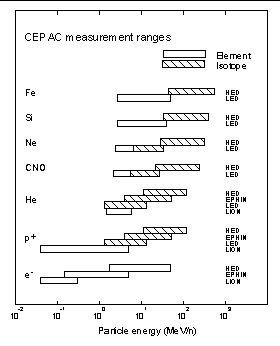|
Two energetic particle proposals were submitted to ESA in response to the SOHO
Announcement of Opportunity in 1986. The experiments
ERNE
(Energetic and Relativistic Nuclei and
Electron experiment) and
COSTEP (Comphrehensive SupraThermal and
Energetic Particle analyser) later joined
their forces to better meet the scientific requirements of the mission. The name
of the collaboration is CEPAC i.e. Costep & Erne
Particle Analyser Collaboration
(for a detailed description, see the "CEPAC Experiment Operations Manual").
The two experiments share a common data processing unit (CDPU) forming the
interface to the spacecraft On-Board Data Handling, and a common power
supply (LVPC) forming the interface to the spacecraft power bus. CEPAC has
three sensor units: ESU (ERNE), and EPHIN and LION (COSTEP). The configuration
of CEPAC is shown on right.
The CEPAC instruments and subsystems are mounted to the payload module upper
panel (+X face) with mounting lugs located around the periphery of the mounting
(bottom) surface.

Scientific Objectives
Within the goals of SOHO, the energetic particle experiments will study:
- Steady state processes in the solar atmosphere
- Energy release and particle acceleration in the solar atmosphere
- Samples of solar atmospheric material
- Interplanetary propagation of energetic particles
CEPAC will allow a systematic investigation into these questions by measuring
energetic particles over a wide range of energies and particle species and by combining
this information with simultaneous observations from other SOHO experiments and
with ground based observations. The measurement ranges of a sample of particles are
shown on right.
CEPAC Telemetry and Observation Modes
The total amount of science data to be transferred from the CEPAC common DPU
during every minute is 7616 bytes. This is divided into 32 packages according to
ESA's telemetry standard. The CEPAC experiment is basically a single mode
instrument: when it is turned ON (observation mode) and the nominal operation
is started, it operates automatically, without user's intervention. The only exception
is calibration, which is initiated by telecommands.
CEPAC Ground Support Equipment
A PC-workstation (Common Electrical Ground Support Exquipment i.e. CEGSE) is used
at NASA/SOHO Experimenter Operations Facility (EOF) as the CEPAC interface to the
EOF Core System (ECS). Further, one PC for each CEPAC sensor unit (ESU, EPHIN and
LION) is used for particle data display and monitoring of the unit. This instrument
specific PC is responsible for science data storing, analysis and presentation,
house keeping data analysis and processing.
In addition there is a Digital Alpha workstation for ERNE's scientific data analysis.
That machine runs Digital Unix (a UNIX variant) and the analysis software is written in IDL.
IDL is selected as a standard by SOHO scientists for data analysis and presentation in
SOHO project.
|
|

